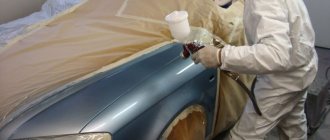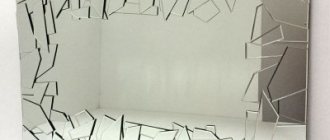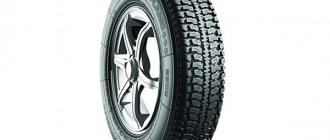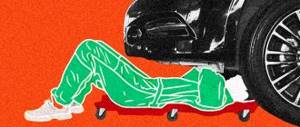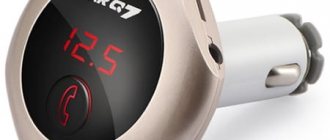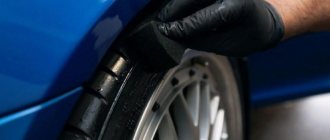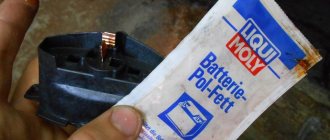Basic anti-corrosion treatment of a car is usually carried out by the manufacturer on the factory assembly line. But many car owners, having bought a new car, try to protect it by carrying out additional anti-corrosion treatment with their own hands. And experience shows that this type of maintenance is 100% justified.
It is worth noting that anti-corrosion treatment of a car is not as difficult a job as it might seem at first glance, and is quite doable on your own.
The video at the end of the article describes in detail and shows how professional anti-corrosion treatment is performed using Tectyl technology.
By treating your car yourself, you can save a lot. The main thing is that your fight against corrosion does not end there. Do not forget that the anti-corrosion treatment of a car must be updated every two years.
Do I need to process it inside the salon?
It is important to know that if a car rots, this process occurs from the inside. If the paint on the outside is scratched down to the metal, then oxidation and the appearance of negative changes will begin to appear after 10 years or more. However, the slightest source of corrosion is enough for the interior of the car. Once it occurs, not even three years will pass before a through hole appears in the body. Electrolyte (water mixed with salt and chemicals) and other liquids will quickly do their job. A small bubble of paint on the threshold will hide a finger-thick hole.
Metal becomes rusty due to exposure to moisture. Contrary to the opinion that this problem concerns products of our automobile industry, foreign cars are not immune from it. They are designed to withstand weather conditions, but water penetrates into the interior in a variety of ways. Most often the reasons are:
- Windshield seal. Due to body deformation, rubber wear.
- Plugs. In case they fall out.
- Joints in the upper part of the body. Welding areas often rust.
- Rotten hood hinges.
- Shumka. In winter and autumn, water drains from shoes and accumulates under the insulation.
Anti-corrosion specialists ask for services from 2500 rubles. If this option is not suitable, it is necessary to seriously study this issue, otherwise the owner may aggravate the problem. First of all, you need to know how to treat the underbody of the car inside the cabin.
First anti-corrosion treatment of a car
It is best to carry out the first anti-corrosion treatment in a specialized workshop, where experienced craftsmen, in addition to the actual treatment of the car, will also drill all the necessary holes and install the fender liners in their places. But if you wish and have some skill, these operations can be performed with your own hands.
During the first anti-corrosion treatment, it is permissible to use inexpensive materials of domestic production. Movil or similar compositions are most often used as an anticorrosion agent Read more about this in the material: How to treat the underbody of a car?
The most vulnerable places for corrosion are the thresholds, boxes above the jack brackets, cross members and reinforcements on the bottom side, side members and doors closed at the ends - they require especially careful treatment.
Anti-corrosion treatment of the car from the inside occurs through special technological holes, that is, without disassembling the body and doors. The maintenance manual for your car should contain a diagram of anti-corrosion treatment indicating all hidden cavities and how to access them.
Tectyl into these places from an aerosol can, because, unlike similar products, it has a flexible tube with a sprayer, with which it is quite convenient to treat hidden cavities.
At service stations, anticorrosive agents are applied in hidden cavities using airless spraying under a pressure of 6-8 atmospheres. During the supply of the composition, it is mixed with air and a certain mist is formed, after drying it produces a very thin, but at the same time with a high degree of protection, anti-corrosion coating. Moreover, it is completely transparent.
After anti-corrosion treatment, plastic fender liners are usually installed in the wheel arches. But the last “squeak” is the so-called liquid fender liners, which are a viscous paste that is applied directly to the body and, after hardening, turns into a kind of plastic.
Here are a few more tricks and useful tips that will help when carrying out anti-corrosion treatment of your car:
- Particular attention should be paid to the uniformity of mastic application: a layer that is too thin will not be strong enough and will begin to quickly collapse under the impacts of small pebbles, and a layer that is too thick will crack and peel off under the influence of vibration.
- The most optimal thickness of the anti-corrosion coating is approximately one and a half to two millimeters. In this case, the mastic consumption will be about 4-5 kilograms per car.
- Before the first signs of corrosion appear, the mechanical properties of the protective layer are more important than the anti-corrosion properties.
- It would be useful to cover the entire floor from the inside with a layer of BPM-1 anti-noise mastic.
- By removing the rubber plugs at the ends of the thresholds, you can significantly extend the service life of the latter. With the fender liners installed, dirt and debris still do not get into these holes, and through ventilation of the sills while the car is moving will only benefit them.
You can carry out anti-corrosion treatment on your car at any time of the year.
Choosing anticorrosive for the inner surface
When selecting a product, it is recommended to take into account a number of indicators. Anticorrosive should:
- have a high level of adhesion;
- densely fill cracks, chips;
- protect the surface from moisture and other liquids;
- preserve areas with rust on the body (although it is better to clean or weld such places);
- displace moisture.
Also, the material must be elastic, otherwise cracks will form on the surface. Mostly these are non-drying products that provide a sufficient level of protection, especially at the junctions of parts and various crevices. Such anticorrosives come with an oil and paraffin base. Their only disadvantage is their instability to mechanical stress, as a result of which they cannot be used on external parts of the body.
For internal treatment, it is better to use oil-based anticorrosives, since mastics dry out, forming a hard surface. One exception: to treat the bottom inside the VAZ's interior, a bituminous composition is required. The coating will have to be renewed more often, but it will eliminate flaws that lead to corrosion.
Manufacturers of processing compounds
There are a number of companies on the market that offer anti-corrosion compounds. This:
- Tectyl;
- Noxudol;
- Dinitrol;
- Waxoyl.
These brands are not cheap, but if you save money on the purchase, you can ruin the body with a low-quality product, and in hot weather it will become impossible to stay in the car due to the strong smell.
Another popular anticorrosive agent is cannon lard. It is petroleum oil thickened with petrolatum. This product is elastic, able to adhere to the surface, does not interact with water, and also withstands extreme temperatures and weather conditions.
A special place is occupied by the processing of car thresholds with your own hands inside. An aerosol can is most often used for this.
Preparing a car for anticorrosion
Before treating the underbody of the car from internal corrosion, the interior must be prepared. In addition, it is important to purchase materials and find tools for work. To perform the manipulations you will need:
- overalls that cover exposed skin;
- protective glasses;
- White Spirit;
- rust converter;
- anticorrosive;
- metal brush;
- industrial dryer;
- sandpaper.
Having collected the necessary accessories, you can begin processing the car. First of all, you need to dismantle the plastic parts that interfere with work. The previous layer of anticorrosive must be cleaned off. Next, thoroughly rinse the surface with hot water and dry. If this is done poorly, the bitumen coating will peel off, compromising the integrity of the anti-corrosion layer.
It is also worth degreasing the surface by wiping it with white spirit. Before treating the car's sills inside, you should first use an anti-corrosion primer, although you can do without it, the main thing is that the metal is clean.
Before treating a car with pushsal, the substance is heated (it is important to control the temperature, the oil should not change color and the consistency should resemble thick sour cream), dilute with a solvent or anti-corrosion agent in a ratio of 1:4. A number of substances are suitable for this: gasoline, used oil, melt-stop. A solution with the latter is most effective, except when the thresholding process is carried out internally. In summer, the composition heats up and, due to the capillary effect, spreads over a large area, filling the cracks, increasing the quality of the coating. It is also recommended to apply the mixture to the car quickly before it thickens.
Choosing a product for treating car thresholds with your own hands
Despite the abundance of various means of protecting thresholds from corrosion, many car enthusiasts are wondering: how to treat thresholds? We will give a complete and comprehensive answer to this question. It will help the car enthusiast make the right choice.
1. Anti-corrosion spray BODY-950, capacity 400 ml
Anti-gravel, created on the basis of special resins. Has high adhesion and is resistant to damage. Application requires the use of a special gun. Dries quickly. Cost 4-6$.
Anti-gravel aerosol ELTRANS, capacity from 400 to 1000 ml.
Inexpensive but effective remedy. Does not require the use of a special gun. Consumption of one layer is 400 grams per 1 m². It is recommended to apply in 2-3 layers. Cost for 400 ml. 2-3$.
The procedure for applying anti-corrosion protection to the bottom from the inside
Having figured out how to treat the bottom of the car inside, you need to find out how to do it. There are different types of anticorrosion packaging: metal and plastic containers, aerosol cans and cylinders for a special gun.
The better the car's thresholds are treated inside, the longer the car will last, because this is one of the most vulnerable parts to corrosion. Anticorrosion is applied using an aerosol can according to the following rules:
- shake immediately before use;
- start spraying, keeping it at a distance of fifteen centimeters from the surface;
- take five-minute breaks between applying layers;
- apply the mixture at least three times;
- when finished, dry with an industrial hair dryer;
- Replace the protection and let the vehicle sit for two to three hours before use.
There is also the option of applying bitumen anticorrosive, but it is more labor-intensive and provides less protection.
The body treatment occurs in the same sequence, with the only difference being that a brush is used instead of an aerosol. It is necessary to carefully coat the surface in two or three layers, paying attention to all seams, cracks and hard-to-reach places. In special cases, it is more convenient to use a spray can than to cover the inside of the car with your own hands using a brush, but this is not very effective. In the case of pushsal, an aerosol for a car cannot be used - during the spraying process, the composition quickly hardens and does not lie on the surface.
When processing with mastic, it is worth heating it up, this increases adhesive properties and helps fill hard-to-reach places. It should be remembered that mastic hardens longer than oil, so if you apply a thick layer, the vehicle will be inoperative for about a week.
When choosing what to treat the bottom of the car inside the cabin, you need to remember that the issue of using different anticorrosion agents remains individual for each car enthusiast. Fortunately, many stores and websites provide an assortment and the opportunity to find an option that matches the characteristics of the machine.
Repeated anti-corrosion treatment of the car
Repeated anti-corrosion treatment of a car is usually carried out every two years. At the same time, the hood and trunk lids, reinforcements of the engine compartment, trunk and floor on the interior side can be processed less frequently.
Preparing the machine for applying anticorrosion and the processing process itself is as follows:
- Before repeated anti-corrosion treatment, first of all, you need to wash the car thoroughly and clean all drainage holes.
- We advise you to pay special attention to the large number of hidden cavities and pockets - a lot of dirt accumulates in them, which over time leads to corrosion (read more about how to properly wash your car).
- After washing the car, it must be dried, and only then proceed with anti-corrosion treatment.
- Wipe areas of the bottom with damaged, cracked or peeling anti-corrosion material with gasoline and apply a fresh layer of anti-corrosion material.
- Pay special attention to the wing arches and the areas around the perimeter of the fender liners.
If the treatment was carried out irregularly, then in some places (usually on the bottom of the car) the factory anticorrosive agent may be damaged to the metal. This is where red spots appear, which eat through the iron in 2-3 years.
In this case, before applying the anti-corrosion coating, rather labor-intensive work must be carried out to remove rust, which is performed either mechanically (with abrasive skins), or using chemical compounds (rust converters), or electrochemically. We talked in detail about rust removal here.
Areas of the body that have been stripped down to metal must be primed, after which anti-corrosion mastic can be applied.
When choosing a mastic for re-processing the underbody of a car, you should first of all pay attention to its anti-corrosion properties and only then to its mechanical strength.
If you decide to carry out repeated anti-corrosion treatment at a specialized station, then do not forget to first remove the fender liners, otherwise the wheel arches will remain untreated. We also recommend that you read the tips on which car service to choose.
The video below very clearly shows how anti-corrosion treatment is carried out at a branded service station.
